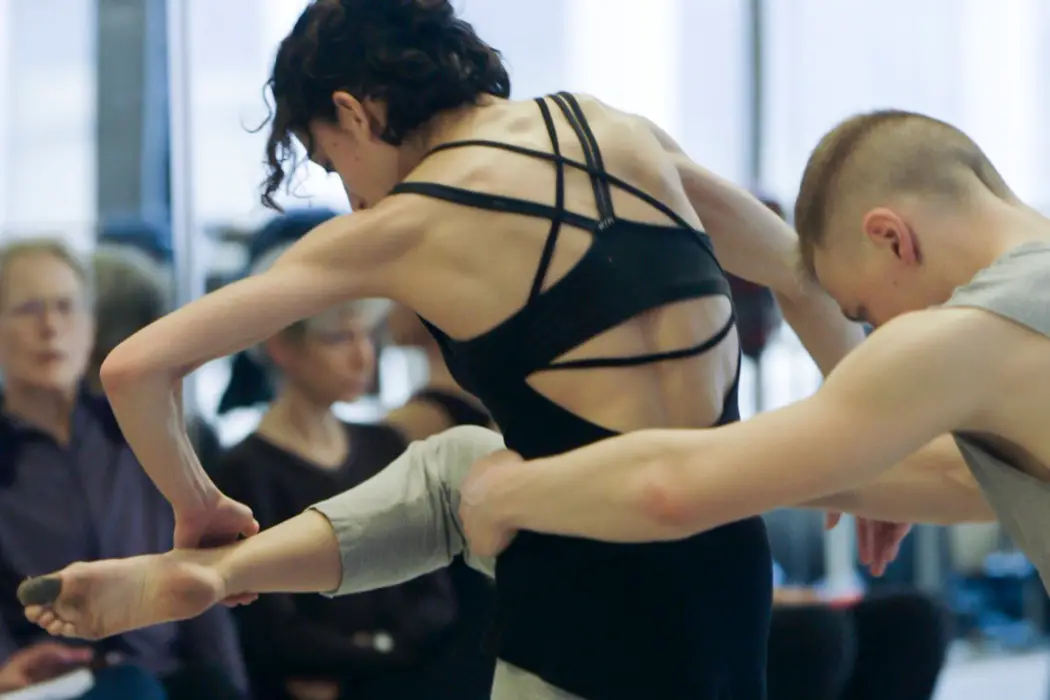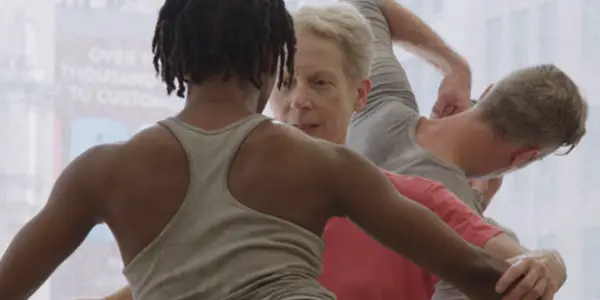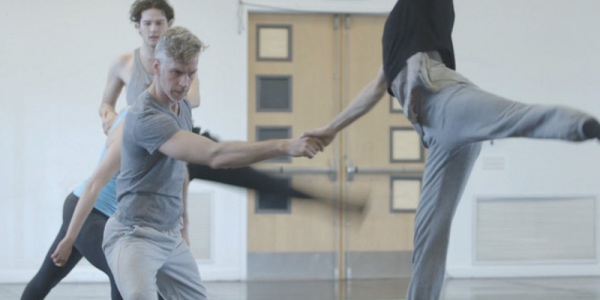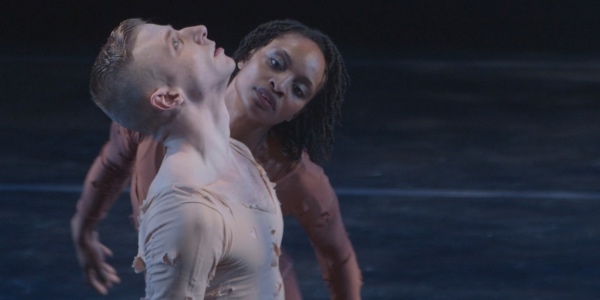IF THE DANCER DANCES: A Fan Tribute To Merce Cunningham

Ivy is a freelance writer and film journalist in NYC…
If the Dancer Dances is a tender, intimate look at how the works of famed dance choreographers are kept alive, given the ephemeral nature of movement itself. With the recent death of Modern Dance legend Merce Cunningham, famed Choreographer Stephen Petrionio felt compelled to stage Rainforest, the late choreographer’s seminal work. He hands his company over to a group of top Cunningham dancers and for the first time takes a back seat to the creative process. The film delves into an aspect of dance that hasn’t been covered this in-depth before: movement vocabularies can only be passed down from dancer to dancer.
“The beauty and tender and amazing thing about dance is that it gets passed from one body, one soul, to another. There’s something precious about that; it’s fragile,” Petrinio muses as the film opens. For the first time, he is setting a piece that’s not his own. Dancers from Cunningham’s company aren’t going to be around forever. Where so much has gone digital, dance is insistently analog. What does this transmission of an entire language of movement look like? If the Dancer Dances is the best way to appreciate this tender, necessary exchange.
Body Talk
What’s fun about this documentary is watching how each Cunningham dancer adds a radically different and necessary piece of the puzzle. Without each new offering the translation isn’t complete. The language of the dance is absorbed by the unique person who interprets it in a different way than anyone else in the company. Cunningham dancers float through offering wisdom and interpretation that prove essential, causing the breakthroughs each company dancer needs to make the movement their own.

It highlights the challenge company dancers face in trying to embody languages of movement that feel completely alien to their bodies when their choreographer decides to try something brand new. This documentary captures that in riveting detail. Their bodies belong to them and to the ideas of the company director. It’s an act of trust that is unique to dance. A musician can put the violin away. The painter can put the brush down. A dancer can’t put her body away. If the job requires learning something that has no emotional or soulful resonance for the performers, how do they get through that to do real justice to the work? Petrinio’s style of dance is the opposite of Cunningham and his dancers work for his company for a reason. Watching a journey that’s unique to this art form widens the appreciation of dance.
What I also loved about If The Dancer Dances is the realistic day-to-day relationships between dancers in a company. Dancers understand they are putting each other’s futures in each other’s hands literally. A bad drop could end a career. A sloppy partner transition that twists an ankle could derail an entire season. Though vicious competition exists, as it does in every artistic profession, it’s rare to see the reality of kindness that is prevalent in the dance world. Watching a dance company gently work through the common goal of a piece was surprisingly entertaining and oddly therapeutic. The sizzle of salacious high-stakes competition sells when it comes to movies about dance. If the Dancer Dances is bold in its rejection of that.
There are always going to be brutal, cut-throat companies. This documentary is encouraging to people thinking of perusing a career in dance, because companies full of nice, kind, sensitive people are common. While demonstrating the challenges of passing down an entire movement vocabulary, it’s the most familiar record I’ve seen of what real dance companies can really be like interpersonally.
A Missed Opportunity
This isn’t a documentary to learn much about Merce Cunningham. It provides no cultural history of why it’s necessary to pass down this man’s work to the next generations and no attempt to explain Modern Dance or Cunningham’s special place in its rich history. The film does actualize the philosophy of Cunningham, which seemed to be about zero narrative, context, or interpretation on anything, giving the audience the space to decide if it’s appealing to them or not. Perhaps this is exactly the way Cunningham would have wanted it.

It’s difficult to say, since I don’t really know anything more about Cunningham after seeing the documentary. The film’s title is from Cunningham: “If the dancer dances all is revealed.” That philosophy alone doesn’t translate well to the medium of a documentary. This complete lack of context makes Stephen’s freak-outs about the magnitude of what he was attempting to pull off fall flat to anyone other than those deeply in the know about Rainforest. Had the film used the medium of cinema to its fullest, it could have been the place to tell the story of Cunningham in a way that people who aren’t dancers could relate emotionally. Some background could have offered insight and appreciation for a great artist’s work. Just a five-minute biography about Cunningham and a bit about Modern Dance would have made this an exceptional film. Without it, it’s largely a fan film.
Why Putting Dance on Film is Difficult
If the purpose of making a film about dance is for it to be appealing to a wide-audience, the thread that viewers can relate to has to be an emotional one. Dancer, about the famed bad-boy of ballet Sergei Polunin, is a study in a compelling dance documentary. His life story and what drove him to become one of the best dancers in the world is haunting and heart-breaking. I still think about that film all the time, and I saw it on a plane while I also had the flu. The emotional weight of the last dance piece packs such a heavy punch. The critically-acclaimed Mr. Gaga, a 2018 documentary about Ohad Naharin, leans on a dance style that is cinematic itself. It’s emotional, music-driven, sensual, erotic, primal, dangerously passionate. All the things that make it impossible to look away. Though, perhaps If the Dancer Dances has it right. Naharin reveals towards the end of Mr. Gaga the story he created as to why he danced was completely made up; trying to put a firm narrative on why he danced felt impossible.
In narrative films about dance cruelty, madness and obsession are often the focus to great entertainment value. And not without validity, the rigor of being a top professional dancer takes something that not a lot of people have and exploring that type of personality is cinema worthy. Black Swan elevated dance to a fever pitch, following in the footsteps of The Red Shoes. Don’t get me wrong. I love these films. In the same way Whiplash doesn’t give anyone access to the true creative process between a mentor and student, dance movies that rely on insanity and extremes can run the risk of forcing dance into more spectacle than art.

Because the truth is the actual process is minute, tedious, pain-staking. And not grueling in the “cymbal to the head” kind of way but in the “watching paint dry” kind of way. Everyone in the arts has stories of the eccentric genius who threw things, screamed profanities and tortured their way into brilliance. The professional artist in any field knows that it’s far more common for the process to be repeating the same thing 100 times with no one watching. And, that’s just not compelling for a camera, hungry for pathos and drama. So, the art must meet the viewer where they are at in a way that makes the art more appreciated than more misunderstood. It may be why the musical is the main way dance has been introduced into film.
The core movement vocabulary of West Side Story is based in the movements of everyday people. And, dancers like Gene Kelly took natural movement and elevated it to the level of sublime. Everyday movement was expanded into art. When it’s a dance form only the most advanced movers can do (and even they struggle with it) and it’s on a stage, removed from everyday life, it can quickly drift into absolute boredom on film. It loses its availability and accessibility. And, if it’s a heady type of movement, removed from Circus Art, that thrives in its generosity of audience inclusion, it can disappear completely into the ethers for anyone but those who know it with their own bodies. Pina, the 2011 tribute to the beloved Pina Bausch, overcomes this hurdle brilliantly by staging the dances in unusual places, like on a bus or in a town square, putting even the most daring moves into someplace recognizable. It sparks the imagination.
Also, what makes If The Dancer Dances unusual is that Cunningham was famous for not marrying music to the dance. The dancers weren’t dancing to the music, they were dancing to counts that were unrelated to the counts in the music. Leaving out why he did that made the lack of a soundtrack to this dance film feel more tedious at times than interesting. In dance films that are beloved by a more mainstream audience, dance and cinemas shared use of music to tell stories works brilliantly. They work together to make the story leap off the screen, often using the same music to blend narrative story-telling with dance pieces. Taking out the emotional undercurrent of music that cinema uses to tell the story of dance without sharing the compelling reason why Cunningham separated the two made If the Dancer Dances feel a bit unfinished and under cooked.
If The Dancer Dances: Conclusion
Though not a perfect film, I’m glad it is in the world. It’s a quality record covering new ground in the dance documentary genre. There is a simple joy in watching experts work their way through hairy problems for a greater good. Merce Cunningham is a huge figure in the dance world. If The Dancer Dances is a great start in unpacking everything that Cunningham represented. I hope more films are made about him. If nothing else, demonstrating how dances are passed down is no small feat and I love If the Dancer Dances for succeeding in that.
What are your favorite dance films and why? Let us know in the comments below!
If the Dancer Dances will be released in the US on April 26, 2019. For all international release dates, see here.
Does content like this matter to you?
Become a Member and support film journalism. Unlock access to all of Film Inquiry`s great articles. Join a community of like-minded readers who are passionate about cinema - get access to our private members Network, give back to independent filmmakers, and more.
Ivy is a freelance writer and film journalist in NYC and LA. Her passion for film started when her family brought home the entire video store from one of their supermarket chains. Her main interests lie in psychological horror and women & cinema. Her work has appeared in Film Inquiry, PopOptique, & Sordid Cinema. She's also a Programmer for the Bushwick Film Festival. More of her work can be found @ thefilmremedy.com













